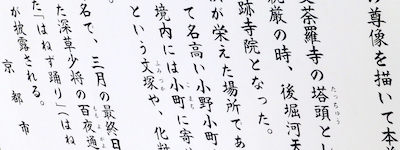As mentioned in previous posts, I started reading Murakami’s 1Q84 in Japanese in October 2014, after I had been learning Japanese for about three years. The paperback (bunko, 文庫) edition consists of 6 volumes, two volumes for each of the three Books that make up 1Q84. Each volume is about 400 pages. In July 2016 I finished the first volume. It is now May 2019 and I have finally finished the four volumes comprising Books 1 and 2.
At first, my reading speed was very slow, about half an hour per page, because I constantly had to look up kanji and grammar constructs. In the last three years, my reading speed has fortunately improved quite a bit: it takes me now five minutes to read a page in Japanese. However, to read the equivalent English translation takes only one minute, so I still have some way to go.
As my reading improved, I started to use different ways of reading.
Reading aloud
In Japanese, “reading aloud” is called rōdoku (ろうどく, 朗読), a word I quite like because rō means “melodious, clear, bright, serene, cheerful”.
Maybe somewhat surprisingly, it turns out that silent reading is a relatively young development: before the 17th century, reading essentially meant reading aloud.
I find reading aloud very useful because it helps me to understand the flow of the sentence and I also find it easier to understand the meaning. There are many other benefits to reading aloud, as explained in this article on Voices.com. A small disadvantage is that I can get stuck on any kanji for which I don’t know the pronunciation – I find it hard to continue without looking it up right away in my dictionary. Still, I like to read aloud also because I simply like the sound of Japanese.
Reading without vocalising
When reading Japanese silently (mokudoku もくどく, 黙読), I usually subvocalise, i.e. I hear the text in my head. However, I found that not doing this has some interesting advantages. I am of course not the first one to make this observation, see e.g. Significance of Silent Reading, but these are my observations for the particular case of reading Japanese as a non-native. For one, I don’t get stuck on unknown kanji readings, so my flow is not broken so easily. Also, it means that I go straight from word shapes to meanings. For example, I do not need to know that 菜食主義者 is pronounced saishokushugisha (さいしょくしゅぎしゃ) to know that it means “vegetarian” (菜 sai is vegetable, 食 shoku is to eat, 主義 shugi is doctrine and 者 sha is person). Even for new words it is often possible to tell the meaning from the kanji – one of the advantages of a writing system based on logograms. When not vocalising, it is not necessary to read every individual character. In Japanese the grammar is usually conveyed using groups of hiragana characters and I find that just geting the overall shape is enough to see if a sequence of characters is a negation, or a polite suffix etc. And finally it allows me to speed-read: I can simply scan the text for kanji that indicate the “interesting” parts. And I can now add speed reading to my vocabulary as well: sokudoku (そくどく, 速読).
Further reading
Here are some articles for your perusal (jukudoku, じゅくどく, 熟読).
- An interesting Japanese article on silent reading and reading aloud: 黙読と朗読・音読の違い.
- About reading, but otherwise unrelated: Reading the Roman alphabet in Japanese isn’t as easy as ABC.
- A chapter from the book “A History of Reading” by Alberto Mangue, The Silent Readers.
